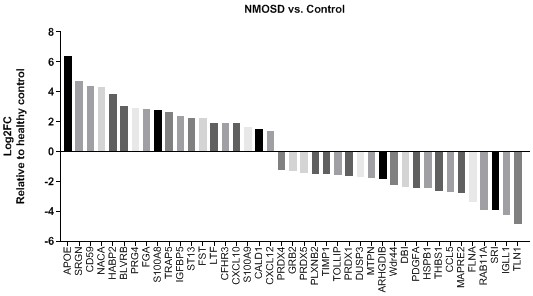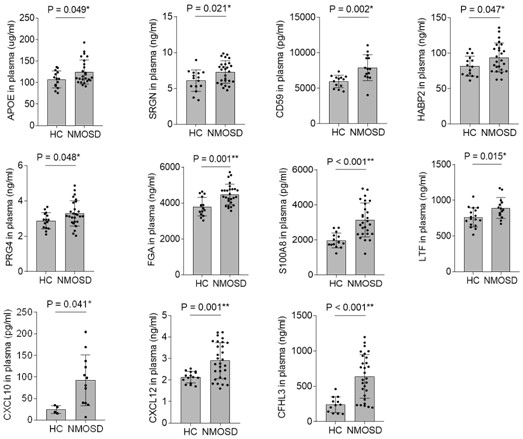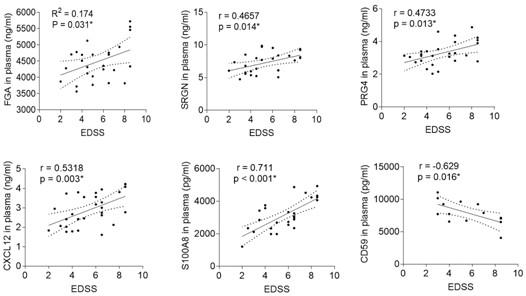Biomarkers and their applications for nmosd prediction or recurrence monitoring
A biomarker and protein technology, applied in the field of biomarkers, can solve problems such as inability to meet clinical needs, and achieve the effect of improving clinical services
- Summary
- Abstract
- Description
- Claims
- Application Information
AI Technical Summary
Problems solved by technology
Method used
Image
Examples
Embodiment 1
[0055] Embodiment 1: The clinical data collection of NMOSD patient and healthy control group
[0056] This study included inpatients in Beijing Tiantan Hospital Affiliated to Capital Medical University from October 2018 to November 2019. Inclusion criteria for NMOSD patients: (1) The age of onset is between 18 and 80; (2) NMOSD patients are clearly diagnosed according to the 2015 Wingerchuk NMOSD diagnostic criteria; (3) Blood AQP4 antibody positive; (4) This is an acute attack : (a) Neurological symptoms such as optic neuritis, transverse myelitis, or acute brain injury that appear newly or are significantly worse than before (i.e. patients must seek medical attention within 7 days after the onset of symptoms). (b) New-onset symptoms must persist for at least 48 hours and not be attributable to other clinical factors (eg, fever, infection, injury, adverse reaction to concomitant medication). (c) New onset symptoms must be consistent with objective clinical signs of sensory, ...
Embodiment 2
[0057] Example 2: Sample collection and storage of NMOSD patients and healthy controls
[0058] 1. Collection of plasma: Collect peripheral blood in purple tubes containing anticoagulant EDTA or heparin, and centrifuge within 30 minutes after sample collection, at 3000 rpm for 10 minutes, at 2-8°C. The upper plasma layer was collected and stored in batches at -80°C. Avoid repeated freezing and thawing of samples. Note: Samples should be centrifuged sufficiently to avoid hemolysis or the presence of particles.
[0059] 2. Extraction of exosomes in peripheral plasma
[0060] Astrocyte-derived exosomes in plasma were extracted by immunosorbent assay.
[0061] 2.1 Magnetic beads (Beads) coated antibody
[0062] 1) Add 100ug of astrocyte surface glutamate transporter antibody (EAAT2-IgG) into the ultrafiltration tube and wash repeatedly;
[0063] 2) Add 8-10ul of biotin (Biotin) with a final concentration of 10mM to the IgG, and let it stand at room temperature for 1-2 hours; ...
Embodiment 3
[0084] Example 3: Proteomics technology analysis, screening out differentially expressed proteins, and obtaining a detection combination of prognostic biomarkers
[0085] 1. The present invention uses the next-generation non-labeled quantitative proteomics technology to complete the analysis. In the data independent acquisition (DIA) mode, it can provide unparalleled proteome coverage and realize the detection of a large number of proteins in each sample at the same time. Precise, highly reproducible quantification. The DIA process provides an ideal platform for qualitative analysis of differentially expressed proteomes or quantitative proteomes of massive samples. The DIA process is based on three necessary steps:
[0086] 1) Construct a spectral library: The spectral library collects all detectable non-redundant high-quality peptide information (MS / MS spectra) of the sample, and serves as a peptide identification template for subsequent data analysis. It contains fragment ...
PUM
 Login to View More
Login to View More Abstract
Description
Claims
Application Information
 Login to View More
Login to View More - R&D
- Intellectual Property
- Life Sciences
- Materials
- Tech Scout
- Unparalleled Data Quality
- Higher Quality Content
- 60% Fewer Hallucinations
Browse by: Latest US Patents, China's latest patents, Technical Efficacy Thesaurus, Application Domain, Technology Topic, Popular Technical Reports.
© 2025 PatSnap. All rights reserved.Legal|Privacy policy|Modern Slavery Act Transparency Statement|Sitemap|About US| Contact US: help@patsnap.com



